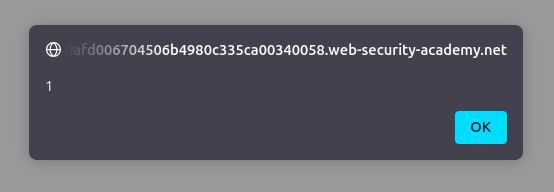Lab: Reflected XSS into a JavaScript string with single quote and backslash escaped
This lab contains a reflected cross-site scripting vulnerability in the search query tracking functionality. The reflection occurs inside a JavaScript string with single quotes and backslashes escaped.
To solve this lab, perform a cross-site scripting attack that breaks out of the JavaScript string and calls the alert function.
Solution
Step 1 : Identifying the Vulnerability
Upon accessing the lab, we find a search bar. Entering a test string (Hi) helps locate how user input is reflected in the page.
Inspecting the DOM reveals that our input appears in three places:
<h1>tag<img>tag- Inside a
<script>tag:
<script>
var searchTerms = 'hi';
document.write('<img src="/resources/images/tracker.gif?searchTerms='+encodeURIComponent(searchTerms)+'">');
</script>Since our input is inside a JavaScript string, we attempt to break out using a single quote ('), but it gets escaped:

var searchTerms = 'hi\'';Trying to escape the escape (\') results in:

var searchTerms = 'hi\\\'';Both single quotes and backslashes are escaped properly, preventing direct string termination.
Exploiting the XSS
Since we can’t escape the string directly, another approach is closing the script tag and injecting our own script.
Payload:
</script><script>alert(1)</script>Explanation:
</script>closes the original<script>tag.<script>alert(1)</script>inserts our own script, executingalert(1).
Execution:
-
Enter the payload into the search bar.

-
The JavaScript executes, triggering an alert box.

By closing the script tag, we bypass input escaping and successfully inject our payload. This technique is useful when escaping mechanisms prevent direct string injections.
